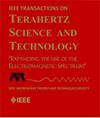VNA Measurement of the IF Output Impedance of an SIS Mixer
IF 3.9
2区 工程技术
Q2 ENGINEERING, ELECTRICAL & ELECTRONIC
IEEE Transactions on Terahertz Science and Technology
Pub Date : 2025-06-12
DOI:10.1109/TTHZ.2025.3579298
引用次数: 0
Abstract
A new method is presented for measuring the intermediate frequency (IF) output impedance (ZIF) of a superconducting tunnel junction (SIS) mixer at cryogenic temperatures. As an example, the impedance ZIF of an atacama large millimeter/submillimeter array band 6 (211–275 GHz) SIS mixer chip was measured at the IF bonding pad. The setup uses a commercial vector network analyzer (VNA) with sensitivity enhancements to increase the dynamic range and allow low-power-one-port reflection coefficient (Γ if) measurements. A coupler inside the VNA is bypassed and replaced with an equivalent cold coupler inside the cryostat. The bias to the mixer is provided through the IF isolator. A cryogenic low-noise amplifier in the return path to the VNA increases its dynamic range. One-port calibration standards (short, open, and 50 Ω) are used, and the impedance is de-embedded from the calibration reference plane to the IF bonding pad of the mixer chip using the proprietary automatic fixture removal capability of the Keysight Technologies VNA. This approach allows direct measurement of the amplitude and phase of ΓIF and hence ZIF, from 2 to 16 GHz with very low power levels at the device under test. The measured results are compared with the predictions made from combining Tucker's quantum mixer theory with electromagnetic model of the mixer.SIS混频器中频输出阻抗的VNA测量
提出了一种在低温下测量超导隧道结混频器中频输出阻抗的新方法。以阿塔卡马大型毫米波/亚毫米波阵列6频带(211 ~ 275 GHz) SIS混频器芯片为例,在中频键合板上测量了其阻抗ZIF。该装置使用具有灵敏度增强的商用矢量网络分析仪(VNA)来增加动态范围,并允许低功耗单端口反射系数(Γ if)测量。旁路VNA内部的耦合器,并用低温恒温器内部等效的冷耦合器代替。混频器的偏置是通过中频隔离器提供的。在VNA返回路径上的低温低噪声放大器增加了其动态范围。使用单端口校准标准(短、开和50 Ω),并且使用Keysight Technologies VNA专有的自动夹具移除功能,将阻抗从校准参考平面解嵌到混合器芯片的IF键合垫上。这种方法允许直接测量ΓIF和ZIF的幅度和相位,从2到16 GHz,在测试设备上具有非常低的功率水平。实测结果与塔克量子混频理论与混频电磁模型相结合的预测结果进行了比较。
本文章由计算机程序翻译,如有差异,请以英文原文为准。
求助全文
约1分钟内获得全文
求助全文
来源期刊

IEEE Transactions on Terahertz Science and Technology
ENGINEERING, ELECTRICAL & ELECTRONIC-OPTICS
CiteScore
7.10
自引率
9.40%
发文量
102
期刊介绍:
IEEE Transactions on Terahertz Science and Technology focuses on original research on Terahertz theory, techniques, and applications as they relate to components, devices, circuits, and systems involving the generation, transmission, and detection of Terahertz waves.
 求助内容:
求助内容: 应助结果提醒方式:
应助结果提醒方式:


